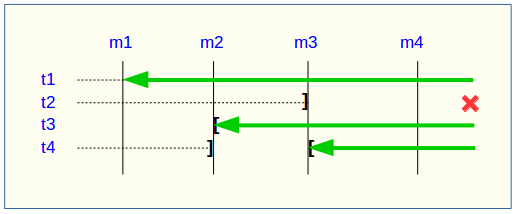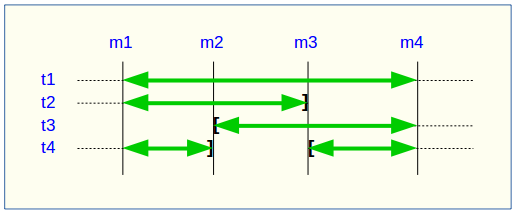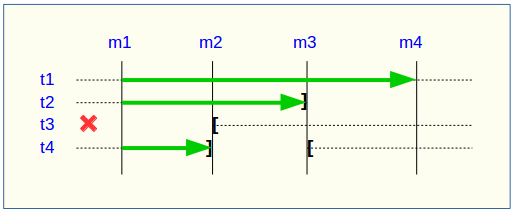Modifying tables groups¶
Several types of events may lead to alter a tables group:
- the tables group definition may change, some tables or sequences may have been added or suppressed,
- one of the parameters linked to a table (priority, schema, tablespaces,…) may have been modified,
- the structure of one or several application tables of the tables group may have changed, such as an added or dropped column or a change in a column type.
Modifying a tables group in IDLE state¶
In all cases, the following steps can be performed:
- stop the group, if it is in LOGGING state, using the emaj_stop_group() function,
- update the emaj_group_def table and/or modify the application schema,
- drop and recreate the tables group, using the emaj_drop_group() and emaj_create_group() functions.
But this last step can be also performed by the emaj_alter_group() function, with a statement like:
SELECT emaj.emaj_alter_group('<group.name>');
The function returns the number of tables and sequences that now belong to the tables group.
The emaj_alter_group() function also recreates E-Maj objects that may be missing (log tables, functions, …).
The function creates and drops the secondary schemas when needed.
Once altered, a tables group remains in IDLE state, but its log tables become empty.
The “ROLLBACKABLE” or “AUDIT_ONLY” characteristic of the tables group cannot be changed using the emaj_alter_group() function. To change it, the tables group must be dropped and re-created using the emaj_drop_group() and emaj_create_group() functions.
All actions that are chained by the emaj_alter_group() function are executed on behalf of a unique transaction. As a consequence, if an error occurs during the operation, the tables group remains in its previous state.
In most cases, executing the emaj_alter_group() function is much more efficient than chaining both emaj_drop_group() and emaj_create_group() functions.
It is possible to update the emaj_group_def table, when the tables group is in LOGGING state. However it will not have an effect until the group is altered (or dropped and re-created).
Using the emaj_alter_groups() function, several groups can be modified at once:
SELECT emaj.emaj_alter_groups('<group.names.array>');
This function allows to move a table or a sequence from one tables group to another in a single operation.
More information about multi-groups functions.
Modifying a tables group in LOGGING state¶
But the previous method has several drawbacks:
- logs recorded before the operation are lost,
- it is not possible to rollback a tables group to a previous state anymore.
However, some actions are possible while the tables groups are in LOGGING state. The following table lists the allowed actions. Details about each method is presented below.
| Action | LOGGING Group | Method |
|---|---|---|
| Change the log schema suffix | Yes | emaj_group_def update |
| Change the E-Maj names prefix | Yes | emaj_group_def update |
| Change the log data tablespace | Yes | emaj_group_def update |
| Change the log index tablespace | Yes | emaj_group_def update |
| Change the E-Maj priority | Yes | emaj_group_def update |
| Remove a table/sequence from a group | Yes | emaj_group_def update |
| Add a table/sequence to a group | Yes | emaj_group_def update |
| Change the group ownership of a table/sequence | Yes | emaj_group_def update |
| Repair a table or a sequence | Yes | chaining remove/add |
| Rename a table | No | |
| Rename a sequence | No | |
| Change the schema of a table | No | |
| Change the schema of a sequence | No | |
| Rename a table’s column | No | |
| Change a table’s structure | No | |
| Other forms of ALTER TABLE | Yes | No E-Maj impact |
| Other forms of ALTER SEQUENCE | Yes | No E-Maj impact |
The “emaj_group_def update” method¶
Most attributes of the emaj_group_def table describing the tables groups can be dynamicaly changed while groups have not been stopped.
To do this, the following steps can be performed:
- modify the emaj_group_def table,
- call one of the emaj_alter_group() or emaj_alter_groups() functions.
For tables groups in LOGGING state, these functions set a ROW EXCLUSIVE lock on each application table of these groups.
On these same tables groups, they also set a mark whose name can be suppled as parameter. The syntax of these calls becomes:
SELECT emaj.emaj_alter_group('<group.name>' [,’<mark>’]);
or
SELECT emaj.emaj_alter_groups('<group.names.array>' [,’<mark>’]);
If the parameter representing the mark is not specified, or is empty or NULL, a name is automatically generated: “ALTER_%”, where the ‘%’ character represents the current transaction start time with a “hh.mn.ss.mmm” pattern.
An E-Maj rollback operation targeting a mark set before such groups changes does NOT automaticaly cancel these changes.
However, the administrator can apply the same procedure to reset a tables group to a prior state.
Incidence of tables or sequences addition or removal in a group in LOGGING state¶
Caution
Once a table or a sequence is removed from a tables group, any rollback operation will leave this object unchanged. Once unlinked from its tables group, the application table or sequence can be altered or dropped.
The historical data linked to the object (logs, marks traces,…) are kept as is so that they can be later examined. However, they remain linked to the tables group that owned the object. To avoid any confusion, log tables are renamed, adding a numeric suffix to its name. These logs and marks traces will only be deleted by a group’s reset operation or by the deletion of the oldest marks of the group.
Caution
When a table or a sequence is added into a tables group in LOGGING state, it is then processed by any further rollback operation. But if the rollback operation targets a mark set before the addition into the group, the table or the sequence is left in its state at the time of the addition into the group and a warning message is issued. Such a table or sequence will not be processed by a SQL script generation function call if the requested start mark has been set before the addition of the table or sequence into the group
Some graphs help to more easily visualize the consequences of the addition or the removal of a table or a sequence into/from a tables group in LOGGING state.
Let’s use a tables group containing 4 tables (t1 to t4) and 4 marks set over time (m1 to m4). At m2, t3 has been added to the group while t4 has been removed. At m3, t2 has been removed from the group while t4 has been re-added.

A rollback to the mark m1:
- would process the table t1,
- would NOT process the table t2, for lack of log after m3,
- would process the table t3, but only up to m2,
- would process the table t4, but only up to m3, for lack of log between m2 and m3.

A log statistics report between the marks m1 and m4 would contain:
- 1 row for t1 (m1,m4),
- 1 row for t2 (m1,m3),
- 1 row for t3 (m2,m4),
- 2 rows for t4 (m1,m2) and (m3,m4).

The SQL script generation for the marks interval m1 to m4:
- would process the table t1,
- would process the table t2, but only up the mark m3,
- would NOT process the table t3, for lack of log before m2,
- would process the table t4, but only up to the mark m2, for lack of log between m2 and m3.

If the structure of an application table has been inadvertently changed while it belonged to a tables group in LOGGING state, the mark set and rollback operations will be blocked by the E-Maj internal checks. To avoid stopping, altering and then restarting the tables group, it is possible to only remove the concerned table from its group and then to re-add it.
When a table changes its affected group, the impact on the ability to generate a SQL script or to rollback the source and destination tables groups is similar to removing the table from its source group and then adding the table to the destination group.
The “Chaining Remove/Add” method¶
Eventhough the event triggers created with E-Maj limit the risk, some E-Maj components that support an application table (log table, sequence or function) may be dropped. In such a case, the associated tables group cannot work correctly anymore.
In order to solve the issue without stopping the tables group (and thus loose the benefits of the recorded logs), it is possible to remove the table from its group and then re-add it. Four steps need to be executed:
- delete the row corresponding to the application table from the emaj_group_def table,
- call the emaj_alter_group() function for the related tables group, in order to effectively remove the table from the group,
- insert again the row corresponding to the table into the emaj_group_def table,
- call the emaj_alter_group() function again in order to re-add the table to the group.
Of course, once the table is removed from its group, the content of the associated logs cannot be used for a potential rollback or script generation anymore.
It may also happen that an application table or sequence be dropped. In this case, the table of sequence can be removed from its group, by chaining these steps:
- delete the row corresponding to the application table or sequence from the emaj_group_def table,
- call the emaj_alter_group() function for the related tables group, in order to effectively remove the table or sequence.